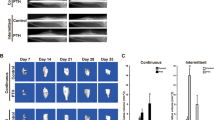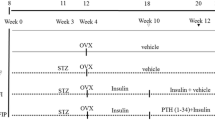Abstract
Long-term use of glucocorticoid (GC) not only reduces bone mass and strength, which leads to a greater risk of fracture, but also hinders fracture repair. In this study, we produced open fractures in GC-treated mice and investigated the effects of human parathyroid hormone 1–34 (hPTH) on fracture repair. Swiss-Webster mice were randomly divided into five groups. Three groups of GC-treated mice were given prednisolone, which was slowly released from subcutaneously implanted pellets at the rate of 1.4 mg/kg/day. Placebo pellets were implanted into the animals in two placebo groups. Three weeks later, osteotomies at the midshaft femora were performed and intramedullary pins were inserted to stabilize the fracture site under general anesthesia. Following fracture surgery, three GC groups were treated subcutaneously with vehicle, PTH at a low dose (40 ug/kg/day), and PTH at a high dose (80 ug/kg/day), respectively. Two placebo groups were given vehicle and PTH at a dose of 40 ug/kg/day, respectively. Radiographs, dual-energy X-ray absorptiometry, and mechanical testing (four-point bending) were used to evaluate fracture repair at 4 weeks after fracture surgery. Callus development, endochondral ossification, and recovery of mechanical strength at the fracture sites in GC animals treated with vehicle were significantly suppressed compared to placebo animals. Normally, PTH accelerates fracture repair. In GC-treated mice, PTH fails to improve endochondral ossification and mechanical properties compared to vehicle treatment, suggesting that the anabolic effect of PTH on fracture healing can be attenuated by GC administration in mice.




Similar content being viewed by others
References
Canalis E, Bilezikian JP, Angeli A, Giustina A (2004) Perspectives on glucocorticoid-induced osteoporosis. Bone 34:593–598
Mazziotti G, Angeli A, Bilezikian JP, Canalis E, Giustina A (2006) Glucocorticoid-induced osteoporosis: an update. Trends Endocrinol Metab 17:144–149
Angeli A, Guglielmi G, Dovio A, Capelli G, de Feo D, Giannini S, Giorgino R, Moro L, Giustina A (2006) High prevalence of asymptomatic vertebral fractures in post-menopausal women receiving chronic glucocorticoid therapy: a cross-sectional outpatient study. Bone 39:253–259
Van Staa TP, Laan RF, Barton IP, Cohen S, Reid DM, Cooper C (2003) Bone density threshold and other predictors of vertebral fracture in patients receiving oral glucocorticoid therapy. Arthritis Rheum 48:3224–3229
Bostrom MP, Gamradt SC, Asnis P, Vickery BH, Hill E, Avnur Z, Waters RV (2000) Parathyroid hormone-related protein analog RS-66271 is an effective therapy for impaired bone healing in rabbits on corticosteroid therapy. Bone 26:437–442
Luppen CA, Blake CA, Ammirati KM, Stevens ML, Seeherman HJ, Wozney JM, Bouxsein ML (2002) Recombinant human bone morphogenetic protein-2 enhances osteotomy healing in glucocorticoid-treated rabbits. J Bone Miner Res 17:301–310
Gilley RS, Wallace LJ, Bourgeault CA, Kidder LS, Bechtold JE (2009) OP-1 augments glucocorticoid-inhibited fracture healing in a rat fracture model. Clin Orthop Relat Res 467:3104–3112
Lindsay R, Zhou H, Cosman F, Nieves J, Dempster DW, Hodsman AB (2007) Effects of a one-month treatment with PTH(1–34) on bone formation on cancellous, endocortical, and periosteal surfaces of the human ilium. J Bone Miner Res 22:495–502
Alkhiary YM, Gerstenfeld LC, Krall E, Westmore M, Sato M, Mitlak BH, Einhorn TA (2005) Enhancement of experimental fracture-healing by systemic administration of recombinant human parathyroid hormone (PTH 1–34). J Bone Joint Surg Am 87:731–741
Andreassen TT, Willick GE, Morley P, Whitfield JF (2004) Treatment with parathyroid hormone hPTH(1–34), hPTH(1–31), and monocyclic hPTH(1–31) enhances fracture strength and callus amount after withdrawal fracture strength and callus mechanical quality continue to increase. Calcif Tissue Int 74:351–356
Kakar S, Einhorn TA, Vora S, Miara LJ, Hon G, Wigner NA, Toben D, Jacobsen KA, Al-Sebaei MO, Song M, Trackman PC, Morgan EF, Gerstenfeld LC, Barnes GL (2007) Enhanced chondrogenesis and Wnt signaling in PTH-treated fractures. J Bone Miner Res 22:1903–1912
Nakajima A, Shimoji N, Shiomi K, Shimizu S, Moriya H, Einhorn TA, Yamazaki M (2002) Mechanisms for the enhancement of fracture healing in rats treated with intermittent low-dose human parathyroid hormone (1–34). J Bone Miner Res 17:2038–2047
Langdahl BL, Marin F, Shane E, Dobnig H, Zanchetta JR, Maricic M, Krohn K, See K, Warner MR (2009) Teriparatide versus alendronate for treating glucocorticoid-induced osteoporosis: an analysis by gender and menopausal status. Osteoporos Int 20:2095–2104
Saag KG, Shane E, Boonen S, Marin F, Donley DW, Taylor KA, Dalsky GP, Marcus R (2007) Teriparatide or alendronate in glucocorticoid-induced osteoporosis. N Engl J Med 357:2028–2039
Saag KG, Zanchetta JR, Devogelaer JP, Adler RA, Eastell R, See K, Krege JH, Krohn K, Warner MR (2009) Effects of teriparatide versus alendronate for treating glucocorticoid-induced osteoporosis: thirty-six-month results of a randomized, double-blind, controlled trial. Arthritis Rheum 60:3346–3355
Lane NE, Yao W, Balooch M, Nalla RK, Balooch G, Habelitz S, Kinney JH, Bonewald LF (2006) Glucocorticoid-treated mice have localized changes in trabecular bone material properties and osteocyte lacunar size that are not observed in placebo-treated or estrogen-deficient mice. J Bone Miner Res 21:466–476
Weinstein RS, Chen JR, Powers CC, Stewart SA, Landes RD, Bellido T, Jilka RL, Parfitt AM, Manolagas SC (2002) Promotion of osteoclast survival and antagonism of bisphosphonate-induced osteoclast apoptosis by glucocorticoids. J Clin Invest 109:1041–1048
Turner CH, Burr DB (1993) Basic biomechanical measurements of bone: a tutorial. Bone 14:595–608
Blunt JW Jr, Plotz CM, Lattes R, Howes EL, Meyer K, Ragan C (1950) Effect of cortisone on experimental fractures in the rabbit. Proc Soc Exp Biol Med 73:678–681
Kostenszky KS, Olah EH (1974) Effect of prednisolone on callus formation. Acta Biol Acad Sci Hung 25:49–60
Kowalewski K (1958) Comparison of the effects of cortisone and certain anabolic-androgenic steroids on the uptake of radiosulfur in a healing fractured bone. Endocrinology 62:493–497
Murakami H, Kowalewski K (1966) Effects of cortisone and an anabolic androgen on the fractured humerus in guinea pigs: clinical and histological study over a six-week period of fracture healing. Can J Surg 9:425–434
Sissons HA, Hadfield GJ (1951) The influence of cortisone on the repair of experimental fractures in the rabbit. Br J Surg 39:172–178
Wiancko KB, Kowalewski K (1961) Strength of callus in fractured humerus of rat treated with anti-anabolic and anabolic compounds. Acta Endocrinol 36:310–318
Weinstein RS, Jilka RL, Parfitt AM, Manolagas SC (1998) Inhibition of osteoblastogenesis and promotion of apoptosis of osteoblasts and osteocytes by glucocorticoids. Potential mechanisms of their deleterious effects on bone. J Clin Invest 102:274–282
Andreassen TT, Ejersted C, Oxlund H (1999) Intermittent parathyroid hormone (1–34) treatment increases callus formation and mechanical strength of healing rat fractures. J Bone Miner Res 14:960–968
Komatsubara S, Mori S, Mashiba T, Nonaka K, Seki A, Akiyama T, Miyamoto K, Cao Y, Manabe T, Norimatsu H (2005) Human parathyroid hormone (1–34) accelerates the fracture healing process of woven to lamellar bone replacement and new cortical shell formation in rat femora. Bone 36:678–687
Manabe T, Mori S, Mashiba T, Kaji Y, Iwata K, Komatsubara S, Seki A, Sun YX, Yamamoto T (2007) Human parathyroid hormone (1–34) accelerates natural fracture healing process in the femoral osteotomy model of cynomolgus monkeys. Bone 40:1475–1482
Nakazawa T, Nakajima A, Shiomi K, Moriya H, Einhorn TA, Yamazaki M (2005) Effects of low-dose, intermittent treatment with recombinant human parathyroid hormone (1–34) on chondrogenesis in a model of experimental fracture healing. Bone 37:711–719
Andreassen TT, Fledelius C, Ejersted C, Oxlund H (2001) Increases in callus formation and mechanical strength of healing fractures in old rats treated with parathyroid hormone. Acta Orthop Scand 72:304–307
Jahng JS, Kim HW (2000) Effect of intermittent administration of parathyroid hormone on fracture healing in ovariectomized rats. Orthopedics 23:1089–1094
Canalis E, Delany AM (2002) Mechanisms of glucocorticoid action in bone. Ann N Y Acad Sci 966:73–81
O’Brien CA, Jia D, Plotkin LI, Bellido T, Powers CC, Stewart SA, Manolagas SC, Weinstein RS (2004) Glucocorticoids act directly on osteoblasts and osteocytes to induce their apoptosis and reduce bone formation and strength. Endocrinology 145:1835–1841
Walsh S, Jordan GR, Jefferiss C, Stewart K, Beresford JN (2001) High concentrations of dexamethasone suppress the proliferation but not the differentiation or further maturation of human osteoblast precursors in vitro: relevance to glucocorticoid-induced osteoporosis. Rheumatology (Oxford) 40:74–83
Luppen CA, Leclerc N, Noh T, Barski A, Khokhar A, Boskey AL, Smith E, Frenkel B (2003) Brief bone morphogenetic protein 2 treatment of glucocorticoid-inhibited MC3T3–E1 osteoblasts rescues commitment-associated cell cycle and mineralization without alteration of Runx2. J Biol Chem 278:44995–45003
Chang DJ, Ji C, Kim KK, Casinghino S, McCarthy TL, Centrella M (1998) Reduction in transforming growth factor beta receptor I expression and transcription factor CBFa1 on bone cells by glucocorticoid. J Biol Chem 273:4892–4896
Yao W, Cheng Z, Pham A, Busse C, Zimmermann EA, Ritchie RO, Lane NE (2008) Glucocorticoid-induced bone loss in mice can be reversed by the actions of parathyroid hormone and risedronate on different pathways for bone formation and mineralization. Arthritis Rheum 58:3485–3497
Annefeld M (1992) Changes in rat epiphyseal cartilage after treatment with dexamethasone and glycosaminoglycan-peptide complex. Pathol Res Pract 188:649–652
Kember NF, Walker KV (1971) Control of bone growth in rats. Nature 229:428–429
Dearden LC, Mosier HD Jr, Brundage M, Thai C, Jansons R (1986) The effects of different steroids on costal and epiphyseal cartilage of fetal and adult rats. Cell Tissue Res 246:401–412
Mushtaq T, Ahmed SF (2002) The impact of corticosteroids on growth and bone health. Arch Dis Child 87:93–96
Altman A, Hochberg Z, Silbermann M (1992) Interactions between growth hormone and dexamethasone in skeletal growth and bone structure of the young mouse. Calcif Tissue Int 51:298–304
Allen DB (1996) Growth suppression by glucocorticoid therapy. Endocrinol Metab Clin North Am 25:699–717
Folkman J, Ingber DE (1987) Angiostatic steroids. Method of discovery and mechanism of action. Ann Surg 206:374–383
Folkman J, Langer R, Linhardt RJ, Haudenschild C, Taylor S (1983) Angiogenesis inhibition and tumor regression caused by heparin or a heparin fragment in the presence of cortisone. Science 221:719–725
Maragoudakis ME, Sarmonika M, Panoutsacopoulou M (1989) Antiangiogenic action of heparin plus cortisone is associated with decreased collagenous protein synthesis in the chick chorioallantoic membrane system. J Pharmacol Exp Ther 251:679–682
Beamer B, Hettrich C, Lane J (2010) Vascular endothelial growth factor: an essential component of angiogenesis and fracture healing. HSS J 6:85–94
Acknowledgements
The authors thank Ms. Li Jiang and Dr. Keith W. Condon for animal care and assistance with tissue processing. We thank Dr. Lang Li at the Division of Biostatistics, Indiana University School of Medicine, for his advice on biostatistical analysis. We are also grateful to Dr. Joseph Bidwell at the Department of Anatomy and Cell Biology, Indiana University School of Medicine, for critical reading of the manuscript.
Author information
Authors and Affiliations
Corresponding author
Additional information
The authors have stated that they have no conflict of interest.
Rights and permissions
About this article
Cite this article
Doyon, A.R., Ferries, I.K. & Li, J. Glucocorticoid Attenuates the Anabolic Effects of Parathyroid Hormone on Fracture Repair. Calcif Tissue Int 87, 68–76 (2010). https://doi.org/10.1007/s00223-010-9370-3
Received:
Accepted:
Published:
Issue Date:
DOI: https://doi.org/10.1007/s00223-010-9370-3




